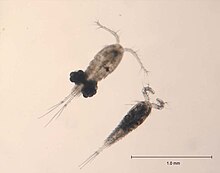Hoppers
| Hoppers | ||||||||||||
|---|---|---|---|---|---|---|---|---|---|---|---|---|

Hopperling ( Cyclops ) |
||||||||||||
| Systematics | ||||||||||||
|
||||||||||||
| Scientific name | ||||||||||||
| Cyclops | ||||||||||||
| Müller , 1776 |
The hoppers ( Cyclops ) are a genus of copepods (Copepoda). Their scientific name is derived from the Cyclops (Cyclops), one-eyed legendary figures from Greek mythology, because even hoppers only have one eye, the middle (median) Nauplius eye .
features
The hoppers grow to be 0.5–1 mm long. They are clearly divided into two body sections. The broad, oval front part consists of the head and the first five breast segments. The rear is much slimmer. It consists of the narrow sixth breast and four legless abdominal segments and has two abdominal appendages at the end. The long first antennae in the smaller males are transformed into grasping organs with which the females are held during mating. After being laid, the females attach their eggs to the body in two sacks.
Way of life
Locomotion
The common name "Hüpferling" can be traced back to the way the animals move. The first antennae jerk backwards and the recoil causes the animal to snap forward. Then it slides back a little to "hop" forward again.
food
The hoppers live on small parts of plants, animals or carrion. They also serve as food for fry and predatory insects themselves.

Occurrence
The hippopotamuses occur worldwide in fresh water , less often in brackish water . They live in the bank zones of plant-rich standing and weakly flowing waters. About 20 species are represented in the standing waters of Central Europe. There are over 100 species throughout Europe and over 400 worldwide. They can survive unfavorable living conditions in a mucous coat, which is formed by special skin glands. This cyst formation enables smaller bodies of water to be colonized, which are affected by regular dehydration. There are even some hoppers in lanes and tree holes.
These small animals are also found in aquariums. They are usually introduced with plants.
Epidemiological Significance
In the distribution regions of the medina worm, hippopotamuses, as hosts for its larvae, play the decisive role in its spread and the development of dracunculosis in humans, but also in other mammals, especially domestic dogs. The main preventive measure is to filter the drinking water.
literature
- Ulrich Einsle : Copepods (Crustacea, Copepoda) from temporary small bodies of water in the western Lake Constance area (Cyclops stagnalis n. Sp.) , In: Writings of the Association for the History of Lake Constance and its Surroundings , 114th year 1996, pp. 101-109 ( digitized )
- Wilfried Stichmann: Kosmos Naturführer , p. 264; Kosmos Publishing House. ISBN 3-440-09454-5 .
